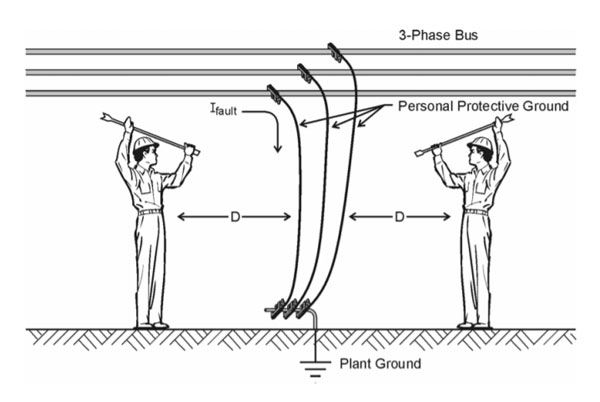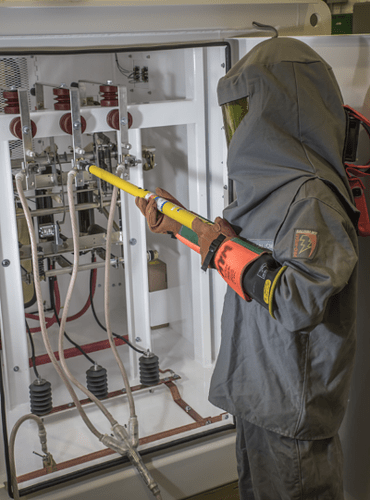Personal protective grounding establishes a temporary connection between an electrical system and the earth, which allows any unexpected current to be safely diverted away from maintenance personnel and into the ground. This helps prevent electric shock and electrocution during maintenance and testing activities.
Grounding prior to electrical maintenance involves cable connected to de-energized lines by jumping and bonding with appropriate clamps, to limit the voltage difference between accessible points at a worksite to safe values if the lines or equipment are accidentally re-energized.

Personal protective grounds should be placed to create an equipotential zone at the work location. Safety grounds are sized with consideration to the available short circuit current and duration of the fault. Photo: USBR.
Protective grounds are sized to carry the maximum available fault current at the worksite. Also called ground jumper, it is an intentional low impedance path to ground.
Any person working on de-energized high-voltage equipment is responsible for understanding protective grounding requirements and procedure. Only trained and qualified workers shall apply and remove temporary personal protective grounds.
Note: Temporary protective grounds should be placed to create an equipotential zone at the work location. Safety grounds are sized with consideration to the available short circuit current and duration of the fault. Safety grounds should not be of excessive length because they could start to move violently under a fault condition and injure someone. Reference NFPA 70B Section 7.7.4.2.4
Step 1: De-energize the line in accordance with procedures
Use a documented LOTO procedure to be certain that the circuit or equipment has been de-energized and isolated from all sources of hazardous energy. Temporary protective grounds should be placed to create an equipotential zone in the working area at the work location, preferably.
Step 2: Test the circuit for voltage
Don’t assume that the circuit has been de-energized just because it’s been turned off. Other sources of energy, such as induction from nearby circuits, can result in lethal shocks and other injuries.
Conductor-end clamps must be applied and disconnected by hot sticks of adequate rating and length. Always wear the appropriate levels of shock and arc-flash hazard PPE when applying grounds.
It is required to perform a 3-point test with a sensitive voltage testing devices to verify a zero energy state. Examples of sensitive voltage testing devices include “proximity” testers, such as glow sticks (similar to light pens), tic-tracers (they make a sound), or direct-reading HV voltmeters.
-
A 3-point test consists of testing the voltage tester on a known energized source to verify it is working properly (Test No. 1).
-
Then, test the circuit on which work is to be performed (Test No. 2).
-
Finally, test the voltage tester on the same energized source as was used in Test No.1 to verify the tester is still working properly (Test No. 3).
IMPORTANT: Always wear the appropriate levels of shock and arc-flash hazard PPE when applying grounds. See: Electrical Shock and Arc Flash PPE Overview
Step 3: Clean all connections
Extra resistance caused by corrosion and dirt should be eliminated to maintain an extremely low resistance to ground, otherwise single point grounding will be ineffective.
Step 4: Apply ground-end clamps first, and remove them last
This assures there is no time during installation in which the operator could become the lowest-resistance ground path. Mechanical connections should be strong enough to withstand forces generated by electromagnetic induction.
Step 5: Conductor-end clamps must be applied and disconnected by hot sticks of adequate rating and length
If it is physically impossible to use hot line tools for the application of grounds, additional shock and arc rated PPE is required for worker protection.
Safety Procedures and Employee Training
Overall, the safety of workers performing personal protective grounding depends on proper training, adherence to established safety procedures, and the use of appropriate personal protective equipment and testing equipment.
Employers must take a proactive approach to safety and provide workers with the necessary resources to ensure a safe working environment. Additionally, employers should establish clear safety protocols and provide regular safety audits to ensure that workers are following established procedures.

